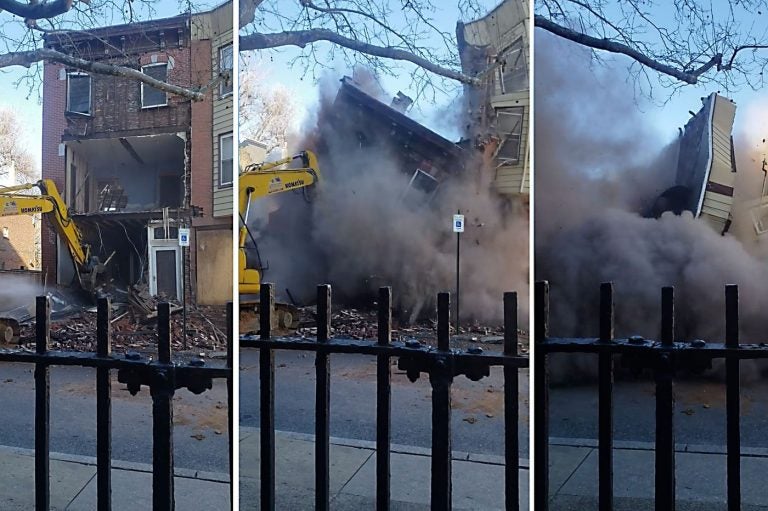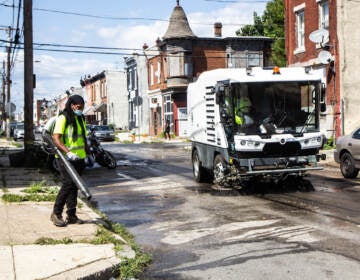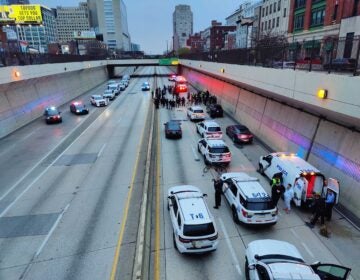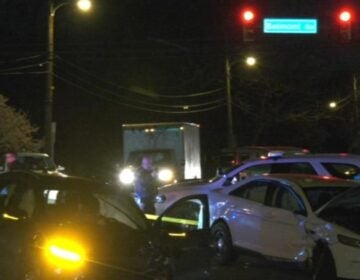Cheat Sheet: What to do if you suspect illegal or negligent construction in Philly
Residents can report dangerous construction and take steps to prevent accidents. Here are five straightforward tips for keeping your home and neighborhood safe.

Two Fishtown homes, located at 633 and 635 E. Thompson St. collapsed after the city's Department of Licenses and Inspections declared both properties imminently dangerous. (L&I Riverwards Coalition)
Negligent and illegal construction can destroy nearby properties — and it’s a growing problem in a city experiencing unprecedented levels of building in rowhouse neighborhoods.
The Philadelphia residents behind the Riverwards L+I Coalition began organizing last year, after a contractor working without proper permits improperly excavated a basement and caused the rowhouse next door to collapse. The Thompson Street incident was an extreme example of a problem that neighbors in the rapidly redeveloping areas have watched worsen. Two months later, a nearby house on Tulip Street collapsed. Both incidents were caused by unpermitted workers digging out basements improperly and destroying the shared walls that keep rowhouses standing.
Within the first four months of 2019, illegal construction had damaged more properties than is typical in a full year, city officials said in April.
In an interview last spring, Commissioner of Licenses and Inspections Dave Perri attributed the wreckage to climate change and the persistent drive to maximize livable square footage in dense rowhouse neighborhoods.
“The weather is definitely a factor, as well as the greed and ignorance on the part of certain contractors,” Perri said. “That has contributed to a rash of excavation and underpinning failures in Philadelphia.”
But what do these construction terms mean, how can people recognize the signs of a hazard, and what can be done to keep neighborhoods safe?
The volunteer-run Riverwards L&I Coalition is working to answer these questions and improve construction literacy around the city.
At a recent public forum co-hosted by PlanPhilly, Coalition members offered advice on how to identify problem construction, take action and make change. This essay is adapted from a presentation given by the group.
How to spot illegal construction
There are easy ways to check and see if a construction project has gotten the city approvals needed to work legally.
In order to work on a site, developers need a building permit, which can be found online. This is true for erecting a new structure, structurally altering an existing one, or changing the occupancy load in a space — anything that is not a part of regular maintenance.
If you’re concerned about a construction project, first check to see if a permit is posted. All sites are required to have the relevant permits visibly displayed, and permits list exactly what types of work are allowed. If you see work being done that’s not explicitly listed on the permit — that’s a problem: you can report it.
Permits expire! Construction projects can get delayed — it’s important the permits stay up-to-date. You can also report any site working with an expired permit.
How early is too early?
Disturbed by noise, dust or dirt? There are rules intended to mitigate impact. For instance, workers are not allowed to make excessive noise related to construction earlier than 7 a.m. Monday through Friday and 8 a.m. on weekends and holidays. It can’t go later than 8 p.m. any day of the week. If noise is bothering, you can file a complaint through 311 or the city’s Department of Air Management.
How to file a complaint about dust
Building projects should be tidy. If you note any excessive dirt or dust coming from the site, or work happening at odd hours, you can file a complaint through 311 or the city’s Department of Air Management.
Excessive dust can create health problems, particularly for children, elders and people with asthma or other respiratory conditions and when contractors are working on older buildings where asbestos and lead may be present.
Is that sideway blockage allowed?
In order to obstruct walkways, construction projects also need to have a Right of Way permit. Each ROW permit is unique to a given site and cannot be used for neighboring properties. Scan the permit’s QR code to confirm the address listed on the permit matches the building address.
Partial ROW permits allot two feet of sidewalk for pedestrians, whereas full ROW permits block the whole sidewalk.
Should a construction project block the full sidewalk, they must put up barricades to allow a safe route for walking. If there are no barricades or no permits to block the sidewalk, call 911. Stress that someone could get hit.
You can search all licensed sidewalk closures on the Streets Department website.
Gate to danger?
Any area where construction abuts a public path must be fenced off and secured with sandbags. Report ajar fences, or call 911, lest your dog or a curious passerby walk into an active construction site.
How to prevent a common cause of collapse
The recent rowhouse collapses were caused by underpinning on adjacent properties. Underpinning describes the process of reinforcing an existing foundation or deepening a basement floor to increase the amount of usable space in a building. In both cases, the basement floor and soil underneath is excavated out and replaced at a lower level.
In removing soil and bedrock to expand a building’s foundation, underpinning alters the ground on which a whole set of buildings stands. So while the technique is intended to strengthen a building’s foundation, it can do the opposite, if done wrong.
If you see evidence of digging next to the building, check to make sure the permit allows for underpinning. When L&I is aware of structural work, they get a licensed engineer to perform special inspections. This oversight is crucial in preventing damage.
If you see evidence of basement digging without permission, call 911.
Knowing the difference between construction and demolition
A demolition permit is required to remove more than two-thirds of a building’s frame and alter an outside wall.
Builders have to post notice of demolition on the site itself, and the permit will specify if the destruction will be manual or mechanical.
Also: project managers need to send a formal demolition notification to the surrounding properties, with a plan for controlling dust. Should a demolition project surrounding you neglect to provide notice, you are entitled to register a complaint.
Lastly, if a building is coming down, an engineer needs to be on site.
When to call 911
If you see evidence of basement digging without permission, or a project blocking a path without a ROW permit, call 911. Either of these could pose imminent danger to people — emphasize that on the phone.
For other potential violations, call 311, the Fire Department or submit a ticket online.
To connect with other residents concerned about construction safety, take a look at the L+I Coalition’s Facebook group.
WHYY is your source for fact-based, in-depth journalism and information. As a nonprofit organization, we rely on financial support from readers like you. Please give today.






